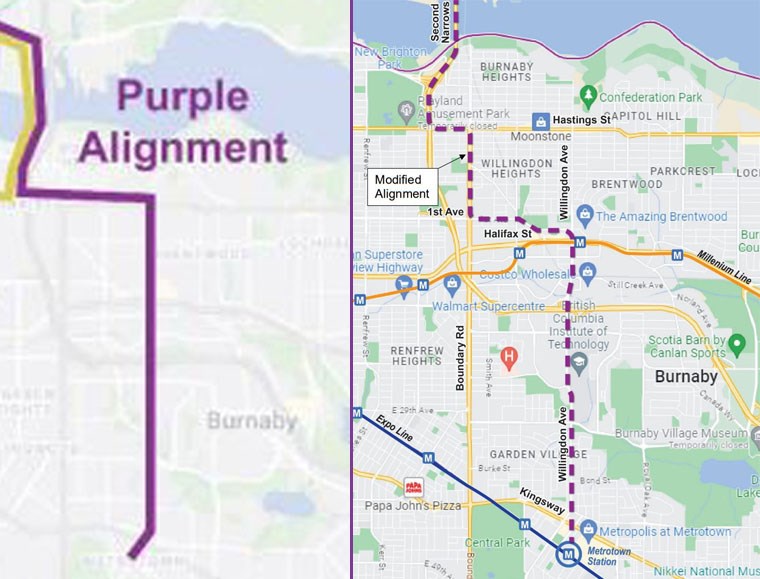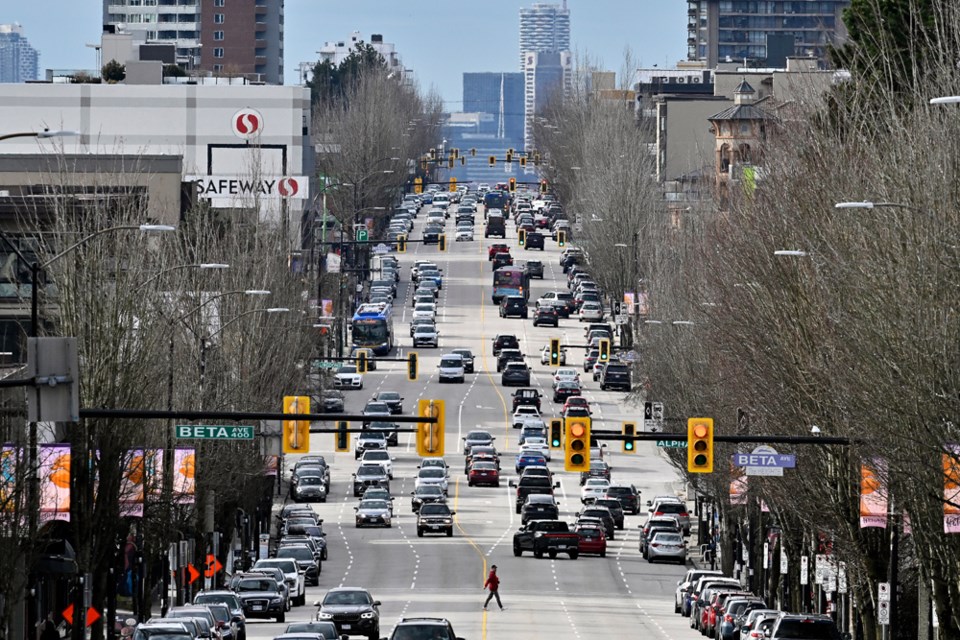Two local advocacy groups are duelling over route options for a high capacity bus route in Burnaby.
TransLink forecasts the bus rapid transit “Purple Line” would see a daily boarding of 55,000 between West Vancouver’s Park Royal mall and Metrotown in Burnaby.
In October, Burnaby engineering staff offered an alternate route that would run down Boundary Road, instead of the original route along Hastings Street in Burnaby Heights, which sparked a saga of back-and-forth debate between the Heights Merchants Association and Movement, an advocacy group representing Metro Vancouver transit riders.
The latest installment came April 15, as volunteers from Movement took to Burnaby City Hall April 15 to lobby for the route through the Burnaby Heights urban village along Hastings Street.
Spencer Powell, a Movement volunteer who lives and works in Burnaby Heights, said the Heights is growing, but it’s always been “a foot-traffic neighbourhood.”
“We need more foot traffic for residents and visitors and excellent transit access that will give the Heights the same competitive edge as Metrotown or Brentwood,” said Powell.
“We cannot build more roads or parking, but we can build a transit system to share this amazing neighbourhood,” Powell said.
“Diverting BRT to Boundary would be a tragic loss of opportunity for the region and the Heights,” Powell said in a Movement press release.

Adding bus priority lanes would make Hastings Street much safer, said Michelle Scarr, Burnaby resident and Movement volunteer.
She said there were two deaths along Hastings last year alone.
“Burnaby’s Hastings is a horrifically dangerous street that took at least two lives last year … Council, it is your responsibility to do something about it,” said Scarr, who also volunteers with Vision Zero Vancouver.
She said the amended Boundary Road line is populated by mostly car dealerships and light industrial businesses and parts of First Avenue don’t have sidewalks, neither of which makes it a good choice for a high capacity bus route.
“There are also lots of people who want to get to Burnaby Heights and easily access important community services like McGill library branch, Confederation Seniors’ Centre, Eileen Dailly and everything else Confederation Park has to offer,” Scarr said.
BRT, which is not the same as Rapid Bus, is a high frequency, high capacity transit service on busy corridors that can be built at “a fraction of the cost of rail-based technology” and is faster to build, according to TransLink.
BRT includes dedicated lanes separated from traffic with signal priority over general traffic, street-level bus stations for fast and convenient boarding, and specialized, articulated buses that allow more passengers.
TransLink estimates the BRT line will cost $250 million to $300 million.
The Purple Line was originally planned to run east on Hastings Street into Burnaby from the Second Narrows bridge, then turn south at Willingdon Avenue and end at Metrotown station.
The alternate route would run down Boundary Road, turn east at First Avenue, then Halifax Street before running south down Willingdon, skipping the Burnaby side of Hastings Street (the Heights).
Staff said the Boundary Road route would be easier to implement, as the Hastings Street alignment would include the loss of travel lanes and on-street parking.
(Some Brentwood residents along Halifax Street have also opposed the Boundary-First-Halifax route due to parking loss.)
But the Heights Merchants is concerned for the 360 “daily goods and services” businesses it represents, noting “in high probability” the bus rapid transit line would mean losing on-street parking spots and affect shoppers.
“A BRT line would literally divide Hastings Street in two and visually divide it as well, making it all but impossible to host car-free street festivals as we’ve done since the 1980s,” says the BIA’s website.
The merchant’s association said bus riders from West Vancouver and Metrotown are not as likely to come to the Heights’s mom-and-pop neighbourhood shops for things like home insurance, groceries, doctors or piano lessons.
“The idea of accommodating possible West Vancouver and Metrotown transit riders at the expense of inconveniencing our local, active, daily shoppers is of concern to us.”
The association supports options that run down Boundary Road and rapid buses along Hastings with bus bulges.
In January, the Heights submitted an official petition to the City of Burnaby with 741 names opposing the Hastings route.
Now, Movement says it has a petition with 965 signatures, with around 60 per cent of them Burnaby residents.
Movement’s petition has not yet been certified by the city.
Burnaby Mayor Mike Hurley told the Movement volunteers the R2 rapid bus will be running more frequently as TransLink studies the corridor this summer.
Hurley thanked the volunteers for their time and said the city will wait for TransLink to come back with more information.
“We have heard you loud and clear, and, of course, you will be taken very seriously,” the mayor said.
It echoed his statement to the Heights Merchants' delegation late last year: “Rest assured that the Heights will be heard,” Hurley said in November.
The Purple Line BRT is a priority project in TransLink's 10-year plan.
Notes on the Purple Line from TransLink
TransLink told the NOW the BRT Purple Line project is in the early planning stages and is still unfunded.
The exact route alignment will be proposed as part of the business case, if the project gets funding from senior government.
TransLink would get approval from each involved municipal council before finalizing the route.
TransLink will engage with "stakeholders" on the project this summer and with the public later in 2024.
The timeline for the Purple Line depends on receiving funding in a future investment plan.
TransLink plans to first extend the R2 RapidBus from Phibbs Exchange in North Vancouver to Metrotown using the existing 222 bus route (which closely follows the original Purple Line alignment along Hastings Street).





